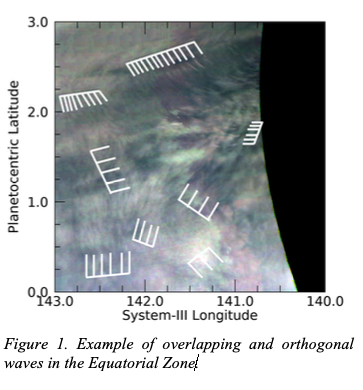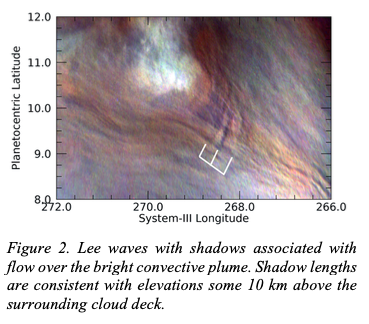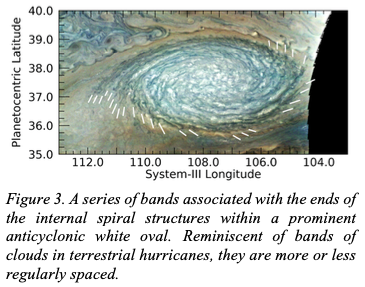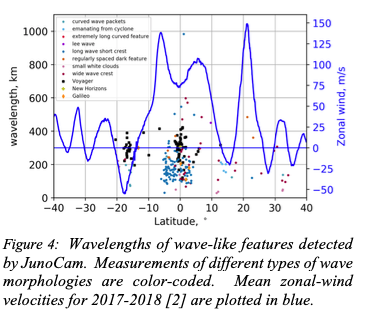A Survey of Small-Scale Waves and Wave-Like Phenomena in Jupiter’s Atmosphere
- 1Jet Propulsion Laboratory, MS 183-501, Pasadena, United States of America (glenn.orton@jpl.nasa.gov)
- 3British Astronomical Association, London, UK
- 4Planetary Science Institute, Tucson, Arizona, USA
- *A full list of authors appears at the end of the abstract
Abstract
In the first 20 orbits of the Juno mission, over 150 waves and wave-like features have been detected by the JunoCam public-outreach camera. A wide variety of wave morphologies were detected over a wide latitude range, but the great majority were found near Jupiter’s equator. By analogy with previous studies of waves in Jupiter’s atmosphere, most of the waves detected are likely to be inertia-gravity waves.
The Juno mission’s JunoCam instrument [1], has detected very small-scale waves. Our survey of JunoCam images revealed a surprising variety of features with wave-like morphologies. They are presented in terms of differences in visual morphology, without implication that this differentiation arises from the associated responsible dynamics.
Long wave packets with short, dark wave fronts represent 79% of the types of waves in our inventory, especially in the Equatorial Zone (EZ) that were also detected in previous studies. These include wave trains with orthogonal wave crests. Even more commonly, we detected wave packets with tilted fronts that are not oriented orthogonally to the wave packet direction. Both the meridional extent and wavelength of these waves are much shorter than the Rossby deformation radius, so it is logical to assume that they are formed by and interact with small-scale turbulence, and thereby propagate the waves in all directions (Fig. 1). Sometimes the short wavefronts are aligned in curved wave packets, all associated with larger features, and located outside the EZ.
Short wave packets with wide wave fronts were also detected. In the Earth’s atmosphere, such waves are often associated with thunderstorms producing a brief impulse period with radiating waves.
Wave packets with bright features appear bright on a dark background rather than dark on a lighter background, like the waves described above. Differences between darker and brighter wave crests could be the composition of the material affected.
Lee waves, stationary waves generated by the vertical deflection of winds over an obstacle, were also detected. Jupiter’s atmosphere no doubt possesses the dynamical equivalent of an obstacle (Fig. 2).
Waves associated with large vortices include compact cyclonic and anticyclonic features with extended radial wavefronts, resembling structures in terrestrial cyclonic hurricanes (Fig. 3).
Long, parallel dark streaks are seen both with a non-uniform patterns and in regularly spaced parallel bands. Their orientation suggests that they are tracing out the direction of flow on streamlines.
Figure 4 plots the distribution of mean wavelengths for different types of waves and wave-like features as a function of latitude, co-plotted with mean zonal wind velocity. The minimum distance between crests is 29.1 km. The variability of wavelengths within a single packet is typically no greater than 20-30%. The equatorial waves with long packets and short crests in the EZ have wavelengths that are clustered between 30 km and 320 km, with most between 80 and 230 km in size. No waves are found at latitudes associated with retrograde zonal flow unless associated with a larger atmospheric feature.
JunoCam, detected 157 waves or wave-like features in its first 20 perijove passes. Of these, 100 are waves with long, linear packets and short crests. Another 25were detected with short packets and long crests. They are all likely to be truly propagating waves, which form the vast majority of features detected, concentrated in a latitude range between 5ºS and 7ºN. Few of these appear to be associated with other features except for waves that appear to be oriented in lines of local flow. There were fewer waves in the EZ between the equator and 1ºN than there were immediately north and south of this band, which was different from the waves detected by Voyager imaging in 1979 that were more equally distributed. Other waves outside the EZ are influenced by other features. These include waves associated with an anticyclonic or cyclonic eddies, lee waves some 10 km above the surrounding cloud deck. Several features appeared within or emanating from vortices. Two sets of extremely long, curved features were detected near the edges of a southwestern extension of a region associated with high 5-µm radiances at the southern edge of the NEB. No waves were detected south of 7ºS that were not associated with larger vortices, such as the GRS. No waves or wave-like features were detected in regions of retrograde mean zonal flow that were not associated with larger features, similar to the waves detected by Voyager imaging.
Acknowledgements
The primary support for this research was provided by NASA, a portion of which was distributed to the Jet Propulsion Laboratory, California Institute of Technology.
References
[1] Hansen et al. Junocam: Juno’s outreach camera. Space Sci. Rev. 217, 475-506. 2017.
[2] Wong et al. High-resolution UV/optical/IR imaging of Jupiter in 2016–2019. Space Sci. Rev. 247, 58. 2020.




Andrew P. Ingersoll (California Institute of Technology, Pasadena, California, USA), Shawn Brueshaber (Western Michigan University, Kalamazoo, Michigan, USA), Michael H. Wog (University of California Berkeley, California, USA; SETI Institute, Mountain View, Caiifornia, USA), Amy Simon (NASA Goddard Space Flight Center, Greenbelt, Maryland, USA), Michael Ravine & Michael Caplinger (Malin Space Science Systems, San Diego, California, USA), Dakota Smith (National Center for Atmospheric Research, Boulder, Colorado, USA), Scott Bolton (Southwest Research Institute, San Antonio, Texas, USA), Chloe Thepenier (Glendale Community College, Glendale, California, USA), Hamish Nicholson (Harvard College, Cambridge, Massachusetts, USA), Abigail Anthony (Golden West College, Huntington Beach, California, USA)
How to cite: Orton, G., Tabataba-Vakili, F., Rogers, J., and Hansen, C. and the JunoCam Waves Investigation Team: A Survey of Small-Scale Waves and Wave-Like Phenomena in Jupiter’s Atmosphere , Europlanet Science Congress 2020, online, 21 Sep–9 Oct 2020, EPSC2020-26, https://doi.org/10.5194/epsc2020-26, 2020.

